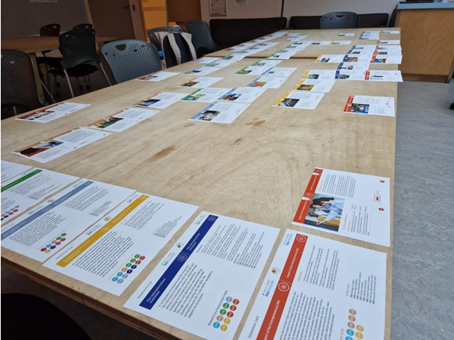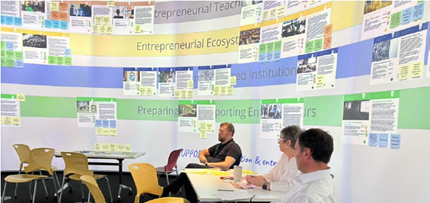University of Technology Sydney: Innovation Strategy Development
Abstract: At the University of Technology Sydney (UTS), HEInnovate played a central role in developing a comprehensive innovation strategy. By combining self-assessment with collaborative workshops involving 38 participants across multiple divisions, UTS used the 56 action cards across all eight HEInnovate dimensions to identify over 450 data points relating to current strengths, immediate opportunities for development, and longer-term strategic priorities for UTS to maintain a comparative advantage as an innovative young university. The tool enabled a broad and inclusive institutional dialogue, laying the groundwork for a formal innovation strategy and ongoing capability building.
Could you share some background about your current work and responsibilities?
 I’m Martin Bliemel, currently serving as Director of Innovation at UTS and previously Associate Dean of Research for the Transdisciplinary School at UTS for four years. In this capacity, I developed the research profile for the pan-university school and am now developing the innovation strategy for the whole university. My academic background focuses on entrepreneurship and innovation—particularly on founders, networks, startup incubators and accelerators, and how universities foster innovation ecosystems. I also design and teach courses in innovation and entrepreneurship that are always highly experiential and simultaneously develop students’ entrepreneurial competencies (following the EntreComp) and evidence to support their ventures.
I’m Martin Bliemel, currently serving as Director of Innovation at UTS and previously Associate Dean of Research for the Transdisciplinary School at UTS for four years. In this capacity, I developed the research profile for the pan-university school and am now developing the innovation strategy for the whole university. My academic background focuses on entrepreneurship and innovation—particularly on founders, networks, startup incubators and accelerators, and how universities foster innovation ecosystems. I also design and teach courses in innovation and entrepreneurship that are always highly experiential and simultaneously develop students’ entrepreneurial competencies (following the EntreComp) and evidence to support their ventures.
What motivated you to use the HEInnovate tool at your university?
We were seeking a structured and evidence-based approach to develop UTS’s innovation strategy. Senior leaders and fellow innovation scholars I contacted worldwide consistently recommended HEInnovate as a well-established and practical framework. We appreciated that it went beyond diagnostics — it provided a language and structure we could use to engage stakeholders and understand what being entrepreneurial really entails across a large university like ours.
How did you approach the HEInnovate self-assessment process?
After piloting the HEInnovate Action Cards at one of our monthly Innovation & Entrepreneurship Collaborative meetups, we quickly realised that greater value would come from engaging more people in a live, collaborative format. We then created a list of 135 people from across all divisions and faculties to invite to a series of hands-on, highly immersive workshops using physical and virtual HEInnovate Action Cards to explore each of the eight dimensions in depth.
Over four targeted sessions, we worked through all 56 HEInnovate Action Cards, with 38 participants attending—some of them multiple times—mainly from leadership roles to ensure strategic alignment. Each participant added sticky notes to the cards from the dimension they were assigned. These sticky notes captured whether the actions recommended by the cards were already well-established (and should not be overlooked), or more aspirational in the medium- or longer-term.
 To make the experience fully immersive, we ran the workshops in our Data Arena—a 360-degree immersive space with floor-to-ceiling screens. We displayed four HEInnovate dimensions, cards and sticky notes on one side of the room and the remaining four on the opposite side, enabling participants to literally stand within a full visualisation of our institutional innovation landscape. Over the course of the four workshops, participants collectively contributed around 450 sticky notes, capturing a rich mix of ideas and evidence across all eight HEInnovate dimensions.
To make the experience fully immersive, we ran the workshops in our Data Arena—a 360-degree immersive space with floor-to-ceiling screens. We displayed four HEInnovate dimensions, cards and sticky notes on one side of the room and the remaining four on the opposite side, enabling participants to literally stand within a full visualisation of our institutional innovation landscape. Over the course of the four workshops, participants collectively contributed around 450 sticky notes, capturing a rich mix of ideas and evidence across all eight HEInnovate dimensions.
What insights or outcomes emerged from this process?
The HEInnovate framework helped us categorise our findings into what we already have in place, what needs immediate attention, and what requires longer-term development. Having the entire framework laid out in an immersive manner allowed participants to ‘see’ how the dimensions interact and support each other. We structured the outcomes from the workshops into recommendations ranging from strategic (leadership, KPIs) to operational (teaching, support services), ensuring alignment with both policy and practice. This led to a 10-page proposal to the Vice Chancellor that evaluated UTS’s performance across all eight HEInnovate dimensions and proposed tangible next steps.
What are the next steps?
Until now, innovation has been referenced within broader strategic documents, but a dedicated Innovation Strategy has not yet existed in its own right. The next key step is to establish an organisational unit that will take clear ownership of the strategy—overseeing its implementation, coordinating institutional efforts, and ensuring regular reporting and accountability. A critical component of that strategy is increasing the innovation capacity
of all academics, professionals and research students. This unit will also be responsible for gathering and managing data, as innovation-related activities often fall between the cracks of traditional reporting systems. While a great deal of institutional data exists, very little of it is directly tied to innovation. Developing meaningful, innovation-specific indicators will therefore be an essential part of embedding the strategy into practice.
Would you recommend HEInnovate to other institutions?
Absolutely. HEInnovate provided us with not just a framework, but a platform for conversation and co-creation of a strategy with workshop participants. It enabled people across UTS to have a voice in shaping our innovation strategy. For us, it wasn’t just about assessing where we are—it was about agreement on inspiring where we could go next.
